Numerical Simulation of Flow and Local Scour Around Structures in Steep Channels Using Two- and Three-Dimensional Hydrodynamic Models
Abstract
1. Introduction
2. Numerical Models
2.1. Governing Equations
2.1.1. Two-Dimensional Shallow-Water Hydrodynamic Model

2.1.2. Three-Dimensional Hydrodynamic Model

2.1.3. Mixed-Sand Bed Deformation Model
2.2. Boundary Conditions
2.3. Numerical Methods
3. Experiments and Calculation Conditions
3.1. Overview of Experiments
3.2. Calculation Conditions
4. Model Applications and Discussions
4.1. Case 1: Fixed-Bed Experiment
4.1.1. Comparisons of Experimental and Calculated Results
4.1.2. Internal Flow by the 3D Hydrodynamic Model
4.2. Case 2: Movable Bed with Uniform-Sand Experiment
4.2.1. Comparisons of Experimental and Calculated Results
4.2.2. Internal Flow by the 3D Model
4.3. Case 3: Movable Bed with Mixed-Sand Experiment
4.3.1. Comparisons of Experimental and Calculated Results
4.3.2. Internal Flow in a Constricted Section
5. Conclusions
Funding
Data Availability Statement
Acknowledgments
Conflicts of Interest
Abbreviations
| a1 | turbulence constant (-) |
| A(i) | fractional area ratio at the boundary of the calculation grid in the xi direction (-) |
| Azb | fractional area ratio in the z direction in the lowest calculation cell (-) |
| B | coefficient of the attenuation function for the eddy viscosity coefficient (-) |
| cs | sediment concentration in the bedload layer (-) |
| Cf | resistance coefficient (-) |
| dl | diameter for the l-th grain (m) |
| dm | mean grain size in the bed surface material (m) |
| Ed | deposition layer thickness (m) |
| Es | bedload layer thickness (m) |
| Et | transition layer thickness (m) |
| Fr | Froude number (-) |
| F2 | blending function (-) |
| fsl | fraction of l-th grain in the bedload layer (-) |
| ftl | fraction of l-th grain in the transition layer (-) |
| ftlL, ftlH | fraction of l-th grain in the transition layer in the lower and upper beds, respectively (-) |
| g | gravitational acceleration (m s−2) |
| h | flow depth (m) |
| hmin | minimum flow depth (m) |
| h0 | uniform flow depth (m) |
| i | subscripts; 1, 2, 3 (-) |
| j | dummy indices; 1, 2, 3 (-) |
| k | turbulent kinetic energy (m2 s−2) |
| kh | depth-averaged turbulent kinetic energy (m2 s−2) |
| kL | lift-drag ratio (-) |
| ks | equivalent sand roughness (m) |
| kw | turbulent kinetic energy at the water surface cell (m2 s−2) |
| Kcl | slope factor for the l-th grain (-) |
| l | number of grain sizes of mixed-sand (-) |
| Lx, Ly | fractional line ratios at the boundary of a horizontal calculation cell in the x and y directions, respectively (-) |
| M, N | flow discharges per unit width in the x and y directions, respectively (m2 s−1) |
| N | Manning’s roughness coefficient (m−1/3 s) |
| N∗ | coefficient for secondary flow strength (-) |
| P | pressure (Pa) |
| Q | discharge (m3 s−1) |
| qbl | bedload transport rate for the l-th grain in the primary flow direction (m2 s−1) |
| qbxl, qbyl | bedload transport rates for the l-th grain per unit width in the x and y directions, respectively (m2 s−1) |
| r | radius of curvature of the depth-averaged flow (m) |
| s | specific gravity of sediment in water (-) |
| S | fractional area ratio in a horizontal calculation cell (-) |
| Sij | mean strain-rate tensor (s−1) |
| St | absolute value of Sij (s−1) |
| t | time (s) |
| ub, vb | near-bed flow velocity components in the x and y directions, respectively (m s−1) |
| ui | flow velocity component in the xi direction (m s−1) |
| u0 | flow velocity in the x direction at the lowest calculation cell (m s−1) |
| u+1, u+2, u+3 | flow velocities in the x direction in the upper cells from the lowest calculation cell (m s−1) |
| u∗ | shear velocity (m s−1) |
| u∗x, u∗y | shear velocities in the x and y directions, respectively (m s−1) |
| U, V | depth-averaged flow velocity components in the x and y directions, respectively (m s−1) |
| Vf | fractional volume ratio in a calculation cell (-) |
| Vfb | fractional volume ratio at the lowest calculation cell (-) |
| x | longitudinal direction for a main flow (m) |
| x1, x2, x3 | x, y, z in Cartesian coordinates (m) |
| y | transverse direction for a main flow (m) |
| z | vertical direction for a main flow (m) |
| z′ | distance from the bed in the vertical upward direction (m) |
| zb | bed level (m) |
| higher bed levels before and after bed slope modification, respectively (m) | |
| lower bed levels before and after bed slope modification, respectively (m) | |
| αs | angle between the primary flow direction and the x direction (-) |
| α1, α2, β1, β2, β* | turbulence constants (-) |
| γl | angle between the direction of l-th grain movement and the direction of maximum bed lope (-) |
| δ | Kronecker’s delta (-) |
| Δ | distance from the solid wall boundary to the nearest calculation point (m) |
| Δw | distance from the water surface to the calculating point of the water surface cell (m) |
| Δt | calculation time step (s) |
| Δx, Δy, Δz | calculation grid sizes in x, y, and z directions, respectively (m) |
| Δzb | vertical grid size of the lowest calculation cell including the bed surface (m) |
| Δz′b | modification value of bed level related to angle of repose in water (m) |
| ζl | angle between the direction of l-th grain movement and the x direction (-) |
| θb | angle of the maximum local-bed slope (-) |
| θx, θy | angle of the bed slope in the x and y directions, respectively (-) |
| κ | von Karman constant (-) |
| λ | porosity of the bed material (-) |
| μs | static friction coefficient (-) |
| ν | kinematic viscosity coefficient (m2 s−1) |
| νh | depth-averaged eddy viscosity coefficient (m2 s−1) |
| νt | eddy viscosity coefficient (m2 s−1) |
| ξ | angle between the direction of the near-bed flow velocity and the x direction (-) |
| ρ | density of fluid (kg m−3) |
| σ | density of sediment (kg m−3) |
| σk1, σk2, σω1, σω2 | turbulence constants (-) |
| τbx, τby | bottom shear stress components in the x and y directions, respectively (Pa) |
| τ∗cl | dimensionless critical tractive force on the flatbed for grain dl (-) |
| τ∗cm | dimensionless critical tractive force on the flatbed for mean grain dm (-) |
| τ∗l | dimensionless tractive force for grain dl (-) |
| τ∗m | dimensionless tractive force for mean grain dm (-) |
| φ | angle of repose in water (-) |
| Ψl | angle between the direction of l-th grain movement and the direction of the near-bed flow velocity (-) |
| ω | specific turbulent dissipation rate (s−1) |
| ωw | specific turbulent dissipation rate at the water surface cell (s−1) |
References
- Locke, H.; Rockström, J.; Bakker, P.; Bapna, M.; Gough, M.; Hilty, J.; Lambertini, M.; Morris, J.; Rodriguez, C.M.; Samper, C.; et al. A Nature-Positive World: The Global Goal for Nature. Available online: https://www.nature.org/content/dam/tnc/nature/en/documents/NaturePositive_GlobalGoalCEO.pdf (accessed on 25 September 2025).
- Soda, R.; Yuhora, K. What was the aim of “Nature-Oriented River Work”? E-J. GEO 2012, 7, 147–157, (In Japanese with English abstract). [Google Scholar] [CrossRef]
- Ministry of Land, Infrastructure, Transport and Tourism of Japan. Neicha-Pojithibu wo Jitsugensuru Kawazukuri wo Susumemasu [We Will Promote River Works That Realizes the Nature-Positive]. Available online: https://www.mlit.go.jp/report/press/mizukokudo04_hh_000236.html (accessed on 25 September 2025). (In Japanese)
- Olsen, N.R.B.; Melaaen, M.C. Three-dimensional calculation of scour around cylinders. J. Hydraul. Eng. 1993, 119, 1048–1054. [Google Scholar] [CrossRef]
- Olsen, N.R.B.; Kjellesvig, H.M. Three-dimensional numerical flow modeling for estimation of maximum local scour depth. J. Hydraul. Res. 1998, 36, 579–590. [Google Scholar] [CrossRef]
- Nagata, N.; Hosoda, T.; Nakato, T.; Muramoto, Y. Three-dimensional numerical model for flow and bed deformation around river hydraulic structures. J. Hydraul. Eng. 2005, 131, 1074–1087. [Google Scholar] [CrossRef]
- Roulund, A.; Sumer, B.M.; Fredsøe, J.; Michelsen, J. Numerical and experimental investigation of flow and scour around a circular pile. J. Fluid Mech. 2005, 534, 351–401. [Google Scholar] [CrossRef]
- Yu, P.; Xu, S.; Chen, J.; Zhu, L.; Zhou, J.; Yu, L.; Sun, Z. Three-dimensional numerical modeling of local scour around bridge foundations based on an improved wall shear stress model. J. Mar. Sci. Eng. 2024, 12, 2187. [Google Scholar] [CrossRef]
- Zhang, H.; Nakagawa, H.; Ishigaki, T.; Muto, Y.; Baba, Y. Three-dimensional mathematical modeling of local scour. J. Appl. Mech. 2005, 8, 803–812. [Google Scholar] [CrossRef]
- Han, X.; Lin, P.; Parker, G. Numerical modelling of local scour around a spur dike with porous media method. J. Hydraul. Res. 2022, 60, 970–995. [Google Scholar] [CrossRef]
- Han, X.; Parker, G.; Lin, P. High-fidelity numerical study of the effect of wing dam fields on flood stage in rivers. Water Resour. Res. 2025, 61, e2024WR037852. [Google Scholar] [CrossRef]
- Zhao, M.; Cheng, L.; Zang, Z. Experimental and numerical investigation of local scour around a submerged vertical circular cylinder in steady currents. Coast. Eng. 2010, 57, 709–721. [Google Scholar] [CrossRef]
- Khosronejad, A.; Kang, S.; Sotiropoulos, F. Experimental and computational investigation of local scour around bridge piers. Adv. Water Resour. 2012, 37, 73–85. [Google Scholar] [CrossRef]
- Hurtado-Herrera, M.; Zapata, M.U.; Hammouti, A.; Van Bang, D.P.; Zhang, W.; Nguyen, K.D. Numerical investigation of the scour around a diamond-and square-shaped pile in a narrow channel. Ocean. Eng. 2024, 309, 118374. [Google Scholar] [CrossRef]
- Jia, Y.; Altinakar, M.; Guney, M.S. Three-dimensional numerical simulations of local scouring around bridge piers. J. Hydraul. Res. 2018, 56, 351–366. [Google Scholar] [CrossRef]
- Quezada, M.; Tamburrino, A.; Niño, Y. Numerical simulation of scour around circular piles due to unsteady currents and oscillatory flows. Eng. Appl. Comput. Fluid Mech. 2018, 12, 354–374. [Google Scholar] [CrossRef]
- Afzal, M.S.; Bihs, H.; Kamath, A.; Arntsen, Ø.A. Three-dimensional numerical modeling of pier scour under current and waves using level-set method. J. Offshore Mech. Arct. Eng. 2015, 137, 032001. [Google Scholar] [CrossRef]
- Gautam, S.; Dutta, D.; Bihs, H.; Afzal, M.S. Three-dimensional computational fluid dynamics modelling of scour around a single pile due to combined action of the waves and current using Level-Set method. Coast. Eng. 2021, 170, 104002. [Google Scholar] [CrossRef]
- Esmaeili, T.; Dehghani, A.A.; Zahiri, A.R.; Suzuki, K. 3D Numerical simulation of scouring around bridge piers (Case Study: Bridge 524 crosses the Tanana River). World Acad. Sci. Eng. Technol. Int. J. Civ. Environ. Eng. 2009, 3, 422–426. [Google Scholar]
- Sumer, B.M. Mathematical modelling of scour: A review. J. Hydraul. Res. 2007, 45, 723–735. [Google Scholar] [CrossRef]
- Lai, Y.G.; Liu, X.; Bombardelli, F.A.; Song, Y. Three-dimensional numerical modeling of local scour: A state-of-the-art review and perspective. J. Hydraul. Eng. 2022, 148, 03122002. [Google Scholar] [CrossRef]
- Choufu, L.; Abbasi, S.; Pourshahbaz, H.; Taghvaei, P.; Tfwala, S. Investigation of flow, erosion, and sedimentation pattern around varied groynes under different hydraulic and geometric conditions: A numerical study. Water 2019, 11, 235. [Google Scholar] [CrossRef]
- Gupta, L.K.; Pandey, M.; Raj, P.A. Numerical modeling of scour and erosion processes around spur dike. Clean–Soil Air Water 2025, 53, 2300135. [Google Scholar] [CrossRef]
- Yan, X.; Mohammadian, A.; Rennie, C.D. Numerical modeling of local scour due to submerged wall jets using a strict vertex-based, terrain conformal, moving-mesh technique in OpenFOAM. Int. J. Sediment Res. 2020, 35, 237–248. [Google Scholar] [CrossRef]
- Chippada, S.; Ramaswamy, B.; Wheeler, M.F. Numerical simulation of hydraulic jump. Int. J. Numer. Methods Eng. 1994, 37, 1381–1397. [Google Scholar] [CrossRef]
- Bayon, A.; Valero, D.; García-Bartual, R.; Vallés-Morán, F.J.; López-Jiménez, P.A. Performance assessment of OpenFOAM and FLOW-3D in the numerical modeling of a low Reynolds number hydraulic jump. Environ. Model. Softw. 2016, 80, 322–335. [Google Scholar] [CrossRef]
- Martínez, B.; Guerra, M.; Riviere, N.; Mignot, E.; Link, O. RANS simulation of supercritical open channel flows around obstacles. J. Hydraul. Res. 2025, 63, 1–14. [Google Scholar] [CrossRef]
- Link, O.; Mignot, E.; Roux, S.; Camenen, B.; Escauriaza, C.; Chauchat, J.; Brevis, W.; Manfreda, S. Scour at bridge foundations in supercritical flows: An analysis of knowledge gaps. Water 2019, 11, 1656. [Google Scholar] [CrossRef]
- Kusakabe, S.; Michiue, M.; Hinokidani, O.; Fujita, M. A numerical simulation of flow pattern and bed variation on widening steep slope channels. In Proceedings of the XXX IAHR Congress, Thessaloniki, Greece, 24–29 August 2003; Theme D. pp. 335–342. [Google Scholar]
- Wu, W. Depth-averaged two-dimensional numerical modeling of unsteady flow and nonuniform sediment transport in open channels. J. Hydraul. Eng. 2004, 130, 1013–1024. [Google Scholar] [CrossRef]
- Yoshitake, H.; Tsubaki, R.; Kawahara, Y. Accuracy of estimated flood discharge hydrograph in steep river by 2-D numerical simulation. J. Jpn. Soc. Civ. Eng. Ser. A2 (Appl. Mech.) 2011, 67, I_683–I_691, (In Japanese with English abstract). [Google Scholar] [CrossRef]
- Juez, C.; Murillo, J.; García-Navarro, P. A 2D weakly-coupled and efficient numerical model for transient shallow flow and movable bed. Adv. Water Resour. 2014, 71, 93–109. [Google Scholar] [CrossRef]
- Chang, K.H.; Wu, Y.T.; Wang, C.H.; Chang, T.J. A new 2D ESPH bedload sediment transport model for rapidly varied flows over mobile beds. J. Hydrol. 2024, 634, 131002. [Google Scholar] [CrossRef]
- Kinose, K.; Taruya, H.; Ikeda, H. Analyses of water surface disturbance and bottom transformation due to pile-like construction on supercritical flow. Trans. Jpn. Soc. Irrig. Drain. Reclam. Eng. 1990, 1990, 123–131, (In Japanese with English abstract). [Google Scholar] [CrossRef]
- Michiue, M.; Hinokidani, O.; Fujii, T.; Matsumoto, K. Jyou–syaryu konzaika no kongousya kasyouhendou simyureisyon [Numerical simulation of bed variation with non-uniform sediment transport in subcritical and supercritical coexisting flow field]. In Proceedings of the 48th Research Presentation, Chugoku Regional Branch Office, Japan Society of Civil Engineers, National Institute of Technology, Tokuyama College, Yamaguchi, Japan, 25–26 May 1996; Volume 48, pp. 207–208. Available online: http://library.jsce.or.jp/jsce/open/00549/1996/48-0207.pdf (accessed on 25 September 2025). (In Japanese).
- Nagase, K.; Michiue, M.; Hinokidani, O. Simulation of bed evolution around contraction in mountainous river. Annu. J. Hydraul. Eng. Jpn. Soc. Civ. Eng. 1996, 40, 887–892, (In Japanese with English abstract). [Google Scholar] [CrossRef]
- Pan, C.; Huang, W. Numerical modeling of tsunami wave run-up and effects on sediment scour around a cylindrical pier. J. Eng. Mech. 2012, 138, 1224–1235. [Google Scholar] [CrossRef]
- Wu, W.; Wang, S.S.Y. Prediction of local scour of non-cohesive sediment around bridge piers using FVM-based CCHE2D Model. In Proceedings of the 1st International Conference on Scour of Foundations, Texas A&M University, College Station, TX, USA, 17–20 November 2002; pp. 1176–1180. [Google Scholar]
- Martínez-Aranda, S.; Murillo, J.; García-Navarro, P. Comparison of new efficient 2D models for the simulation of bedload transport using the augmented roe approach. Adv. Water Resour. 2021, 153, 103931. [Google Scholar] [CrossRef]
- Lane, S.N.; Bradbrook, K.F.; Richards, K.S.; Biron, P.A.; Roy, A.G. The application of computational fluid dynamics to natural river channels: Three-dimensional versus two-dimensional approaches. Geomorphology 1999, 29, 1–20. [Google Scholar] [CrossRef]
- Abdo, K.; Riahi-Nezhad, C.K.; Imran, J. Steady supercritical flow in a straight-wall open-channel contraction. J. Hydraul. Res. 2019, 57, 647–661. [Google Scholar] [CrossRef]
- Hyogo Prefecture, Japan. Kouseido Sanjigen Chiri-Kukan Deita no Katsuyou [Utilization of High-Precision 3D Geospatial Data]. Available online: https://web.pref.hyogo.lg.jp/kk26/hyogo-geo.html (accessed on 25 September 2025). (In Japanese)
- Hirt, C.W.; Sicilian, J.M. A porosity technique for the definition obstacle in rectangular cell meshes. In Proceedings of the International Conference on Numerical Ship Hydrodynamics, 4th, National Academy of Science, Washington, DC, USA, 24–27 September 1985; pp. 1–19. [Google Scholar]
- Uchida, T.; Kawahara, Y.; Kinashi, Y.; Ito, Y. A high-resolution simulator for inundation flows in urban districts and its application to takehara city due to storm surge. Annu. J. Hydraul. Eng. Jpn. Soc. Civ. Eng. 2007, 51, 517–522, (In Japanese with English abstract). [Google Scholar] [CrossRef]
- Nikuradse, J. Laws of flow in rough pipes (Translation of the 1933 paper). In Technical Memorandum, 1292; National Advisory Committee for Aeronautics: Washington, DC, USA, 1950; pp. 1–62. [Google Scholar]
- Menter, F.R. Two-equation eddy-viscosity turbulence models for engineering applications. AIAA J. 1994, 32, 1598–1605. [Google Scholar] [CrossRef]
- Kajikawa, Y.; Moriyama, R.; Kuroiwa, M.; Takeda, M.; Balqis, A.N. Numerical simulation of flow and local scour around a cylinder using various turbulence models in RANS. J. Jpn. Soc. Civ. Eng. Ser. B3 (Ocean. Eng.) 2021, 77, I_295–I_300, (In Japanese with English abstract). [Google Scholar] [CrossRef]
- Yoshida, K.; Kajikawa, Y.; Nishiyama, S.; Islam, M.; Adachi, S.; Sakai, K. Three-dimensional numerical modelling of floods in river corridor with complex vegetation quantified using airborne LiDAR imagery. J. Hydraul. Res. 2023, 61, 88–108. [Google Scholar] [CrossRef]
- Ashida, K.; Michiue, M. Study on hydraulic resistance and bed-load transport rate in alluvial streams. Proc. Jpn. Soc. Civ. Eng. 1972, 1972, 59–69. (In Japanese) [Google Scholar] [CrossRef]
- Nakagawa, H.; Tsujimoto, T.; Murakami, S. Nonequilibrium bed load transport along side slope of an alluvial stream. In Proceedings of the 3rd International Symposium on River Sedimentation, University of Mississippi, Oxford, MS, USA, 31 March–4 April 1986; pp. 885–893. [Google Scholar]
- Luu, L.X.; Egashira, S.; Takebayashi, H. Investigation of Tan Chau reach in lower Mekong using field data and numerical simulation. Annu. J. Hydraul. Eng. Jpn. Soc. Civ. Eng. 2004, 48, 1057–1062. [Google Scholar] [CrossRef]
- Egashira, S.; Ashida, K. Unified view of the mechanics of debris flow and bed-load. Stud. Appl. Mech. 1992, 31, 391–400. [Google Scholar] [CrossRef]
- Ashida, K.; Egashira, S.; Liu, B. Numerical method on sediment sorting and bed variation in meander channel. Annu. J. Hydraul. Eng. Jpn. Soc. Civ. Eng. 1991, 35, 383–390, (In Japanese with English abstract). [Google Scholar] [CrossRef]
- Egiazaroff, I.V. Calculation of nonuniform sediment concentrations. J. Hydraul. Div. 1965, 91, 225–247. [Google Scholar] [CrossRef]
- Iwagaki, Y. Fundamental study on critical tractive force (I) Hydrodynamical study on critical tractive force. Trans. Jpn. Soc. Civ. Eng. 1956, 41, 1–21. (In Japanese) [Google Scholar] [CrossRef]
- Yoshida, K.; Ishikawa, T. Quasi-3D solver of meandering river flows by CIP–soroban scheme in cylindrical coordinates with boundary fitted coordinate method. Annu. J. Hydraul. Eng. Jpn. Soc. Civ. Eng. 2008, 52, 997–1002, (In Japanese with English abstract). [Google Scholar] [CrossRef]
- Uchida, T.; Fukuoka, S. Numerical calculation for bed variation in compound-meandering channel using depth integrated model without assumption of shallow water flow. Adv. Water Resour. 2014, 72, 45–56. [Google Scholar] [CrossRef]
- Jang, C.L.; Shimizu, Y. Numerical simulation of relatively wide, shallow channels with erodible banks. J. Hydraul. Eng. 2005, 131, 565–575. [Google Scholar] [CrossRef]
- Engelund, F. Flow and bed topography in channel bends. J. Hydraul. Div. 1974, 100, 1631–1648. [Google Scholar] [CrossRef]
- Werner, W. Polynomial interpolation: Lagrange versus newton. Math. Comput. 1984, 43, 205–217. [Google Scholar] [CrossRef]
- Kuhnle, R.A.; Jia, Y.; Alonso, C.V. Measured and simulated flow near a submerged spur dike. J. Hydraul. Eng. 2008, 134, 916–924. [Google Scholar] [CrossRef]
- Sugiyama, H.; Akiyama, M.; Matsubara, T. Numerical simulation of compound open channel flow on turbulence with a Reynolds stress model. J. Jpn. Soc. Civ. Eng. 1995, 1995, 55–65, (In Japanese with English abstract). [Google Scholar] [CrossRef]
- Iwasa, Y.; Hosoda, T. Hydraulic analysis of sediment including flows over smooth bed. In Proceedings of the International Conference on Physical Modeling of Transport and Dispersion, Massachusetts Institute of Technology, Boston, MA, USA, 7–10 August 1990; pp. 11B.13–11B.18. [Google Scholar]
- Xing, Y.; Shu, C.W. High order finite difference WENO schemes with the exact conservation property for the shallow water equations. J. Comput. Phys. 2005, 208, 206–227. [Google Scholar] [CrossRef]
- Liu, X.D.; Osher, S.; Chan, T. Weighted essentially non-oscillatory schemes. J. Comput. Phys. 1994, 115, 200–212. [Google Scholar] [CrossRef]
- Shu, C.W.; Osher, S. Efficient implementation of essentially non-oscillatory shock-capturing schemes. J. Comput. Phys. 1988, 77, 439–471. [Google Scholar] [CrossRef]
- Ushijima, S.; Nezu, I. Computational method for free-surface flows on collocated grid with moving curvilinear coordinates. J. Jpn. Soc. Civ. Eng. 2002, 2002, 11–19. [Google Scholar] [CrossRef] [PubMed]
- Hirt, C.W.; Nichols, B.D. Volume of fluid (VOF) method for the dynamics of free boundaries. J. Comput. Phys. 1981, 39, 201–225. [Google Scholar] [CrossRef]
- Spalding, D.B. A novel finite difference formulation for differential expressions involving both first and second derivatives. Int. J. Numer. Methods Eng. 1972, 4, 551–559. [Google Scholar] [CrossRef]
- Hydraulic Formulas Revision Committee, Committee of Hydraulic Engineering, JSCE. Suiri Koushiki Shu, Shouwa 60 nen ban [JSCE Hydraulic Formulas, 1985 Edition]; Japan Society of Civil Engineers: Tokyo, Japan, 1985; p. 13. (In Japanese) [Google Scholar]
- Chow, V.T. Open-Channel Hydraulics; McGraw–Hill: New York, NY, USA, 1959. [Google Scholar]
- Kajikawa, Y.; Kameda, Y.; Ibaraki, R.; Wada, T.; Kuroiwa, M.; Miwa, H. Effects of topographic resolution and flow models on flow and bed deformation analysis at river confluence. Adv. River Eng. 2023, 29, 191–196, (In Japanese with English abstract). [Google Scholar] [CrossRef]





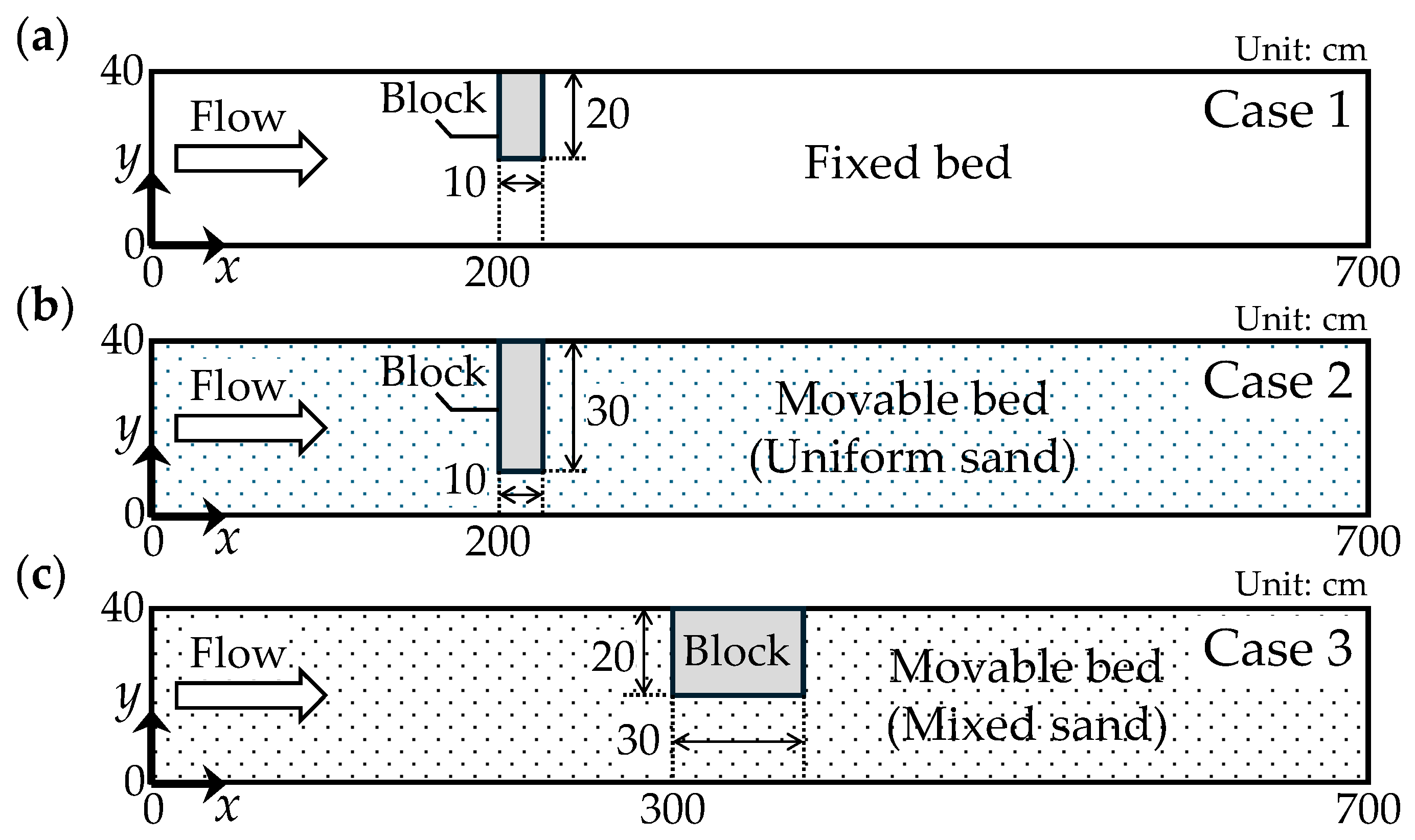


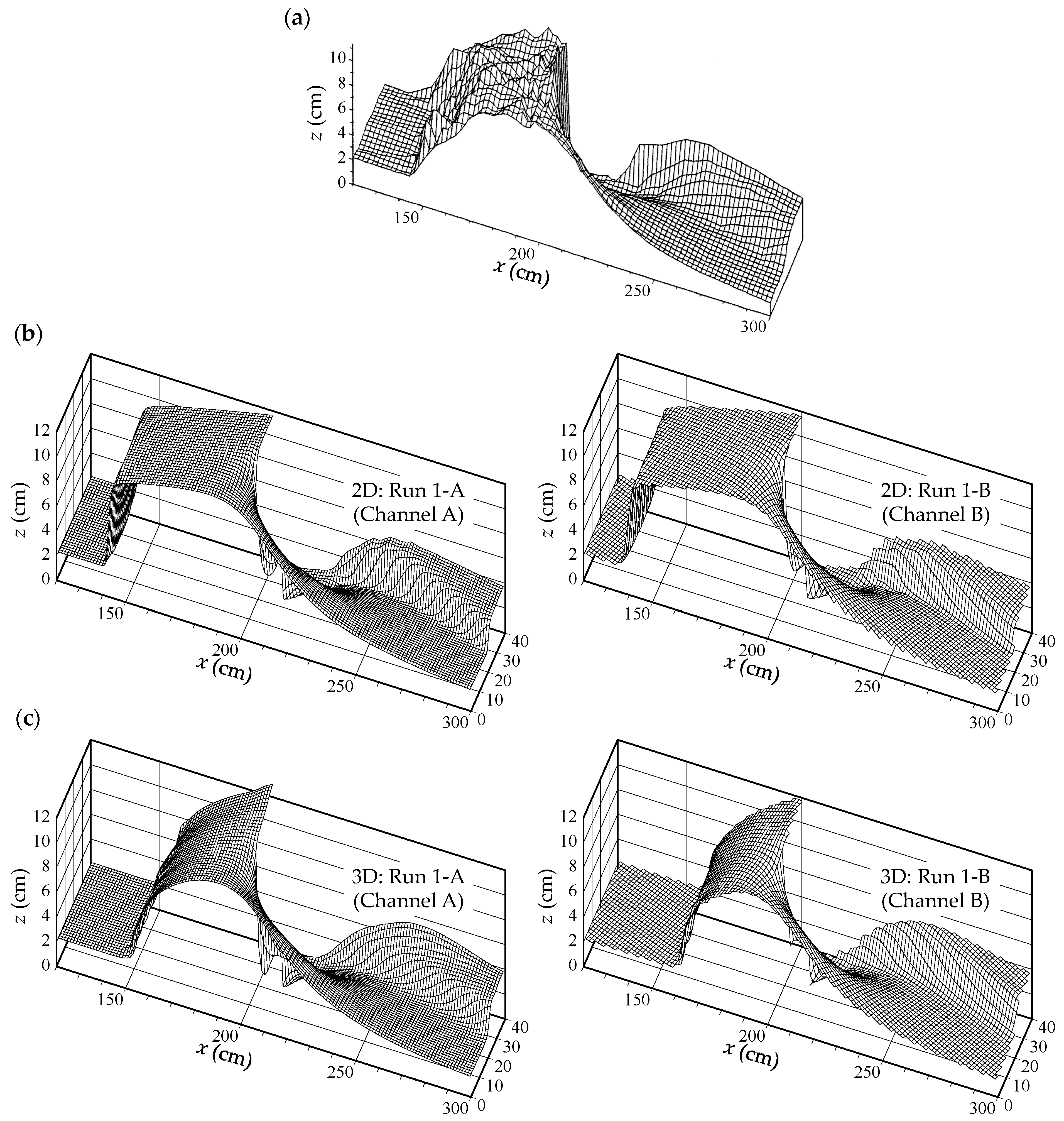
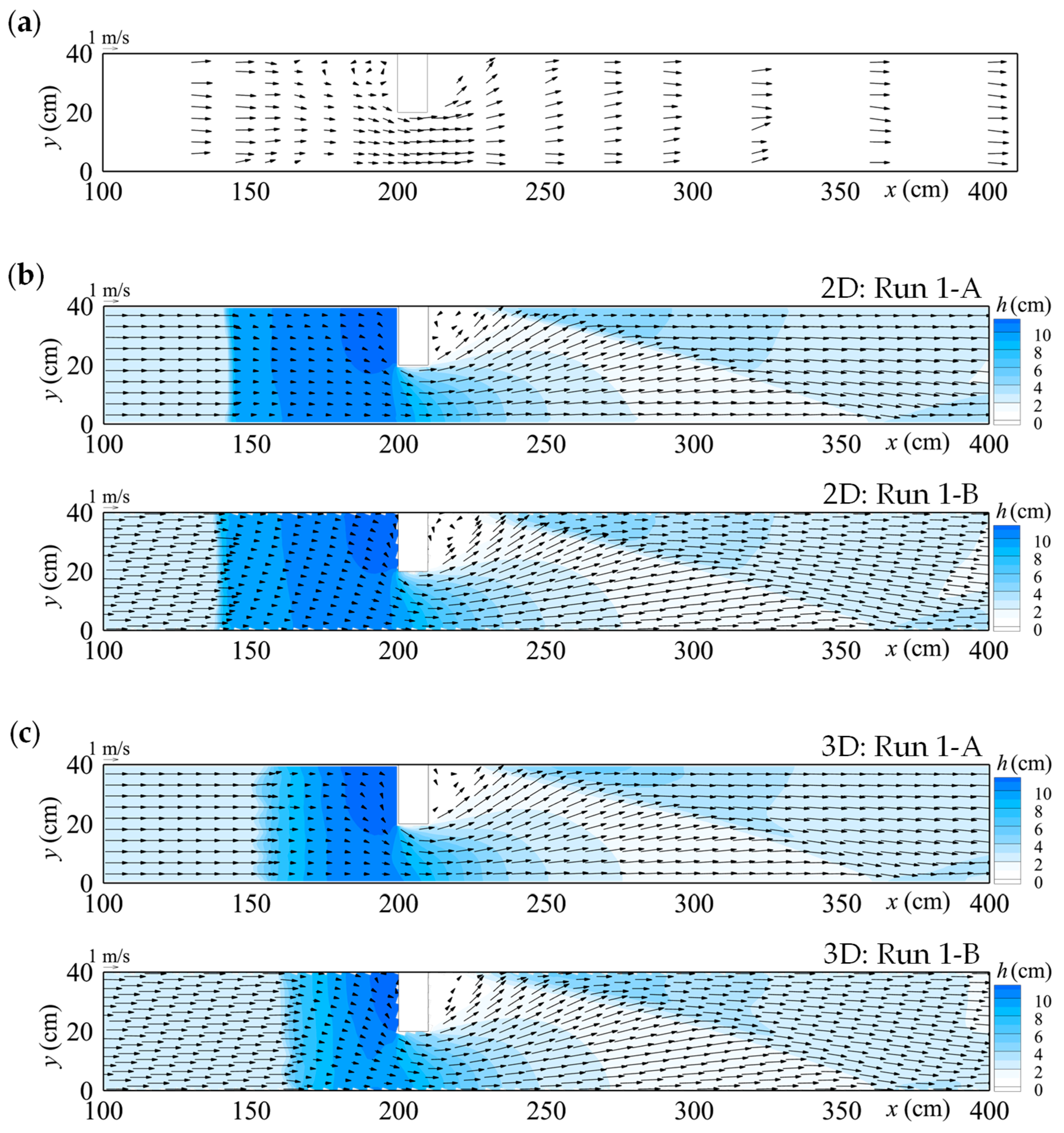

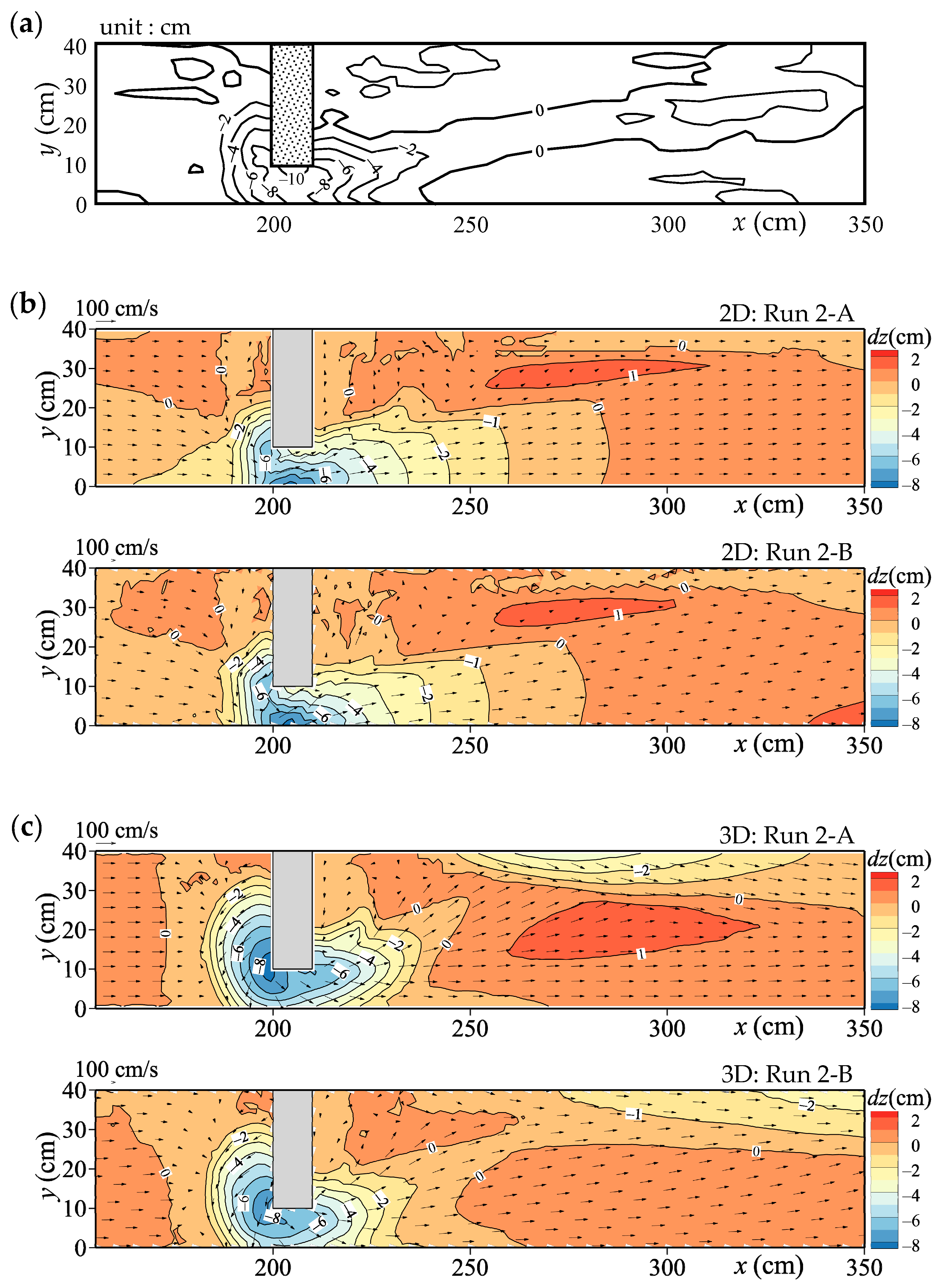
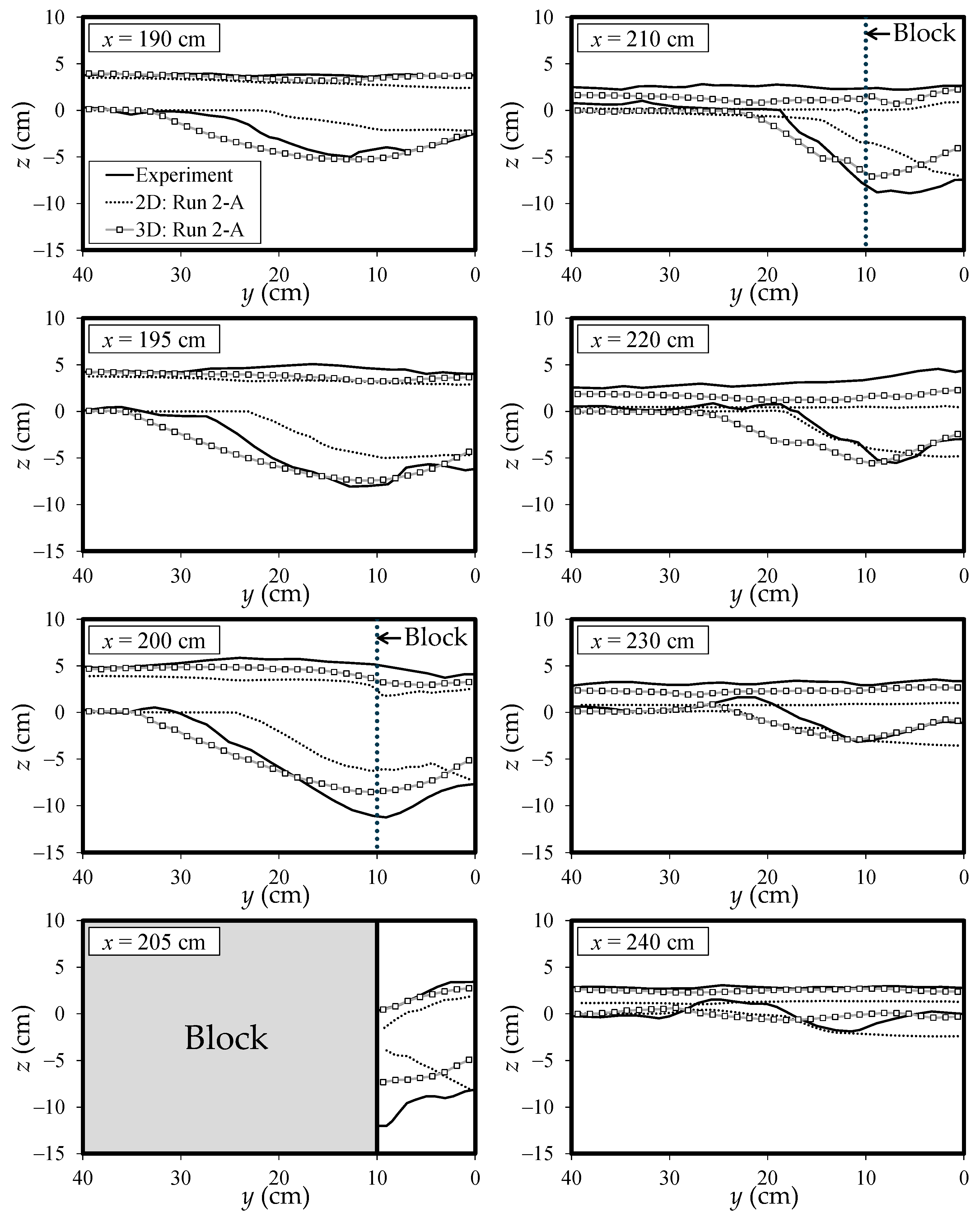

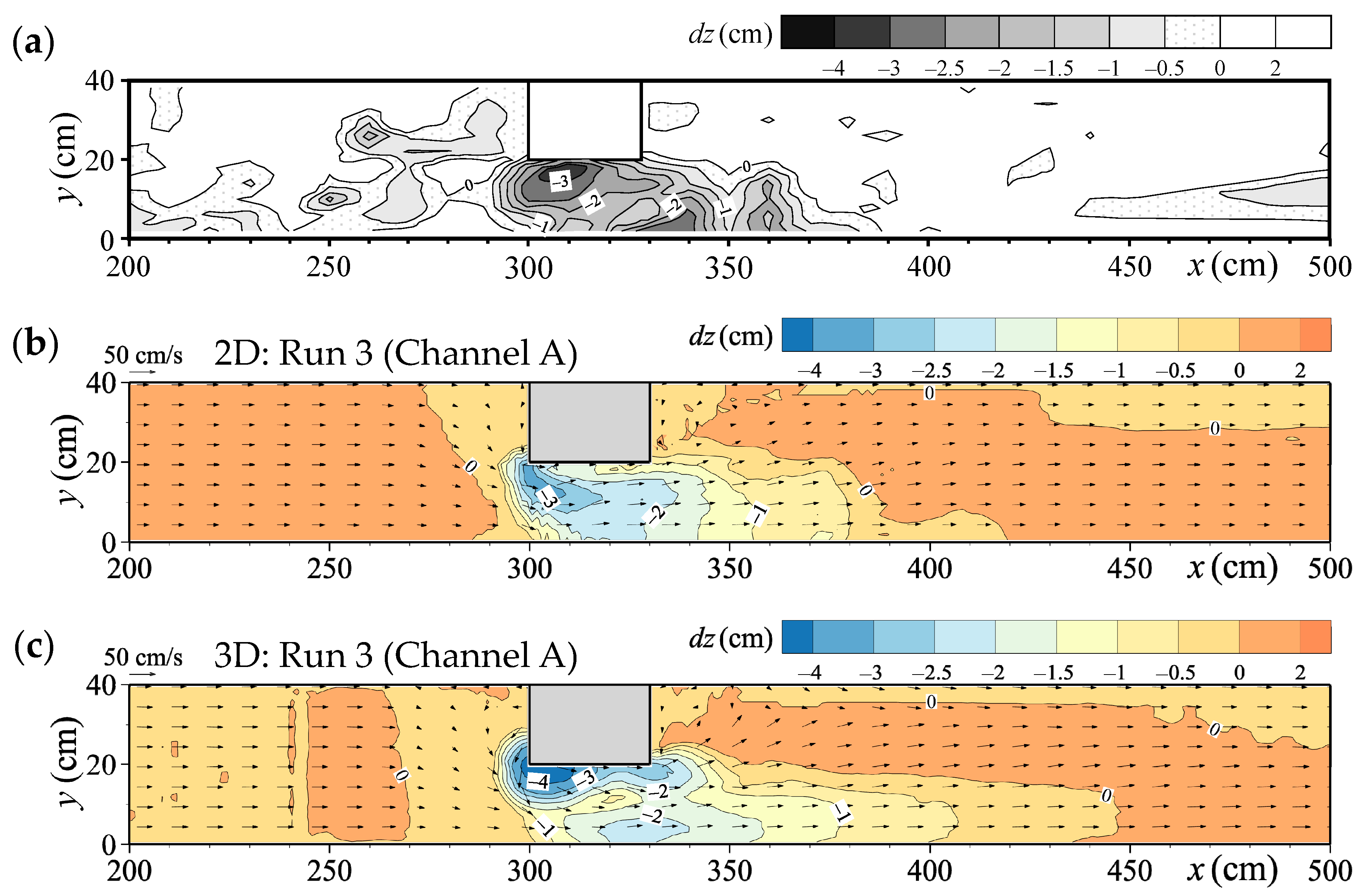
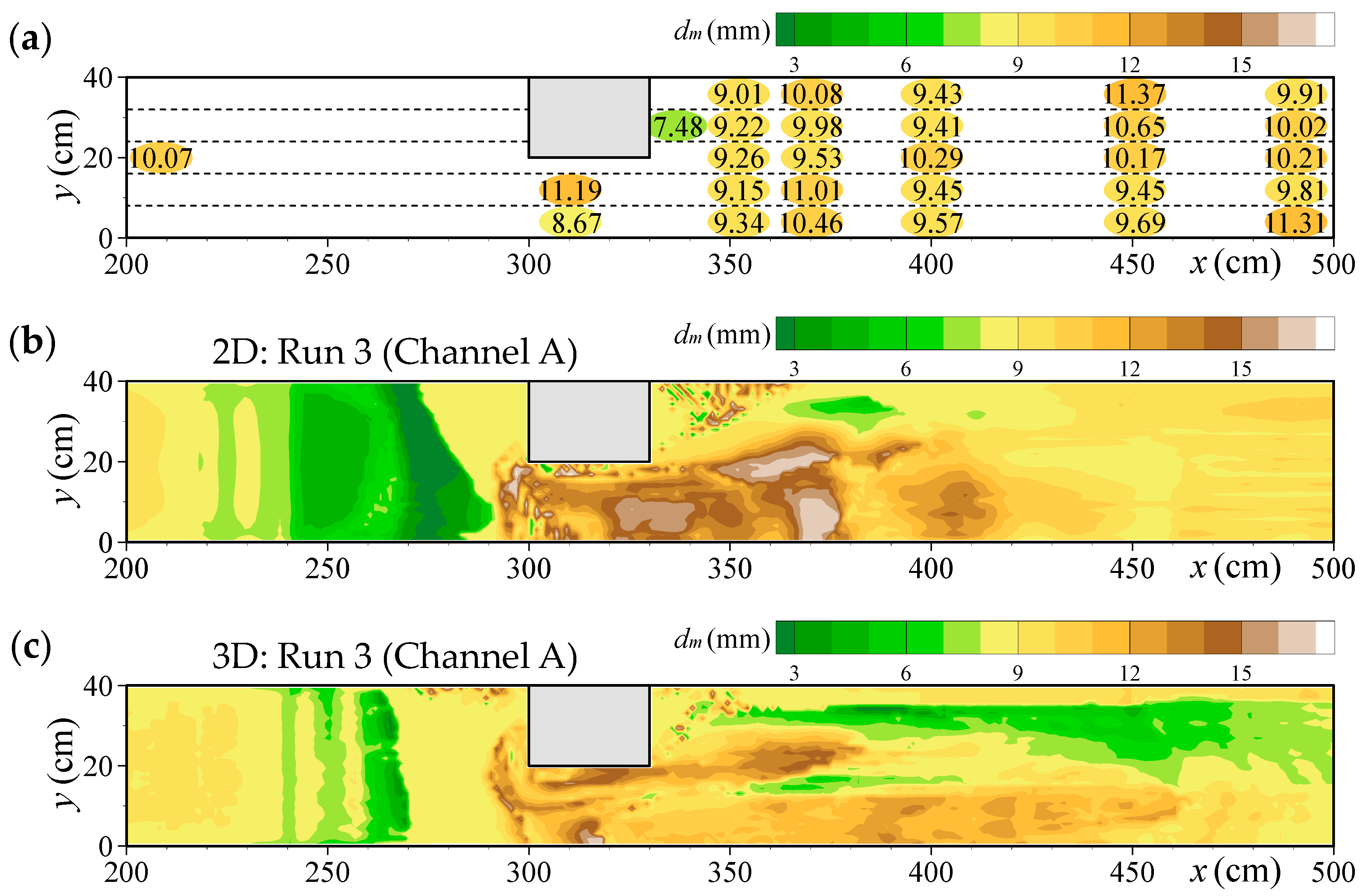


| Case | Bed Condition | Mean Grain Size in the Bed Material dm (mm) | Manning’s Roughness Coefficient n (m–1/3 s) | Bed Slope | Discharge Q (m3/s) | Uniform Flow Depth h0 (m) | Froude Number Fr |
|---|---|---|---|---|---|---|---|
| 1 * | Fixed | ––– | 0.0100 | 1/25 | 0.01360 | 0.0218 | 3.37 |
| 2 ** | Movable | 7.46(Uniform) | 0.0215 for dm | 1/30 | 0.00456 | 0.0189 | 1.40 |
| 3 * | 8.98(Mixed) | 0.0221 for dm | 1/25 | 0.00635 | 0.0222 | 1.53 |
| Run | Experimental Case | Channel Form | 2D Discrete Interval | 3D Discrete Interval | |||
|---|---|---|---|---|---|---|---|
| Δt (s) | Δx, Δy (m) | Δt (s) | Δx, Δy (m) | Δz (m) | |||
| 1-A | 1 | A | 0.0010 | 0.0125 | 0.0005 | 0.0125 | 0.0033 |
| 1-B | B | 0.0158 | 0.0158 | 0.0040 | |||
| 2-A | 2 | A | 0.0020 | 0.0125 | 0.0010 | 0.0125 | 0.0033 |
| 2-B | B | 0.0158 | 0.0158 | 0.0040 | |||
| 3 | 3 | A | 0.0010 | 0.0125 | 0.0010 | 0.0125 | 0.0033 |
Disclaimer/Publisher’s Note: The statements, opinions and data contained in all publications are solely those of the individual author(s) and contributor(s) and not of MDPI and/or the editor(s). MDPI and/or the editor(s) disclaim responsibility for any injury to people or property resulting from any ideas, methods, instructions or products referred to in the content. |
© 2025 by the author. Licensee MDPI, Basel, Switzerland. This article is an open access article distributed under the terms and conditions of the Creative Commons Attribution (CC BY) license (https://creativecommons.org/licenses/by/4.0/).
Share and Cite
Kajikawa, Y. Numerical Simulation of Flow and Local Scour Around Structures in Steep Channels Using Two- and Three-Dimensional Hydrodynamic Models. Water 2025, 17, 3243. https://doi.org/10.3390/w17223243
Kajikawa Y. Numerical Simulation of Flow and Local Scour Around Structures in Steep Channels Using Two- and Three-Dimensional Hydrodynamic Models. Water. 2025; 17(22):3243. https://doi.org/10.3390/w17223243
Chicago/Turabian StyleKajikawa, Yuki. 2025. "Numerical Simulation of Flow and Local Scour Around Structures in Steep Channels Using Two- and Three-Dimensional Hydrodynamic Models" Water 17, no. 22: 3243. https://doi.org/10.3390/w17223243
APA StyleKajikawa, Y. (2025). Numerical Simulation of Flow and Local Scour Around Structures in Steep Channels Using Two- and Three-Dimensional Hydrodynamic Models. Water, 17(22), 3243. https://doi.org/10.3390/w17223243







